Anbang Zhang
Spectral Efficiency-Aware Codebook Design for Task-Oriented Semantic Communications
Aug 06, 2025Abstract:Digital task-oriented semantic communication (ToSC) aims to transmit only task-relevant information, significantly reducing communication overhead. Existing ToSC methods typically rely on learned codebooks to encode semantic features and map them to constellation symbols. However, these codebooks are often sparsely activated, resulting in low spectral efficiency and underutilization of channel capacity. This highlights a key challenge: how to design a codebook that not only supports task-specific inference but also approaches the theoretical limits of channel capacity. To address this challenge, we construct a spectral efficiency-aware codebook design framework that explicitly incorporates the codebook activation probability into the optimization process. Beyond maximizing task performance, we introduce the Wasserstein (WS) distance as a regularization metric to minimize the gap between the learned activation distribution and the optimal channel input distribution. Furthermore, we reinterpret WS theory from a generative perspective to align with the semantic nature of ToSC. Combining the above two aspects, we propose a WS-based adaptive hybrid distribution scheme, termed WS-DC, which learns compact, task-driven and channel-aware latent representations. Experimental results demonstrate that WS-DC not only outperforms existing approaches in inference accuracy but also significantly improves codebook efficiency, offering a promising direction toward capacity-approaching semantic communication systems.
Learning Multi-Rate Task-Oriented Communications Over Symmetric Discrete Memoryless Channels
Aug 24, 2024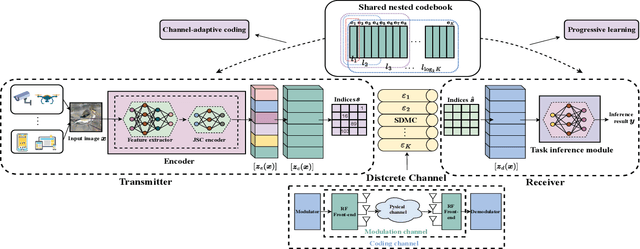

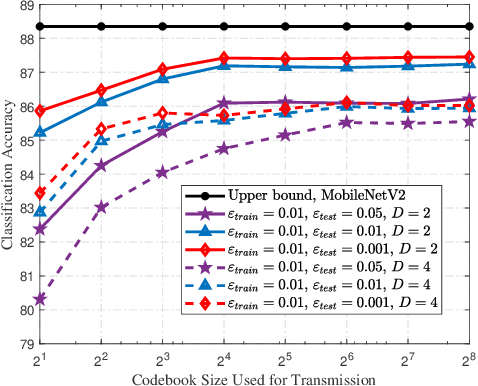
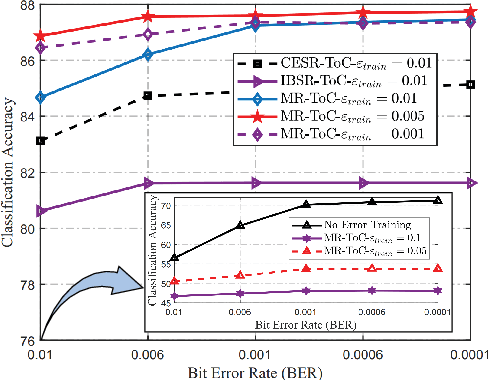
Abstract:This letter introduces a multi-rate task-oriented communication (MR-ToC) framework. This framework dynamically adapts to variations in affordable data rate within the communication pipeline. It conceptualizes communication pipelines as symmetric, discrete, memoryless channels. We employ a progressive learning strategy to train the system, comprising a nested codebook for encoding and task inference. This configuration allows for the adjustment of multiple rate levels in response to evolving channel conditions. The results from our experiments show that this system not only supports edge inference across various coding levels but also excels in adapting to variable communication environments.
Trustworthy Semantic-Enabled 6G Communication: A Task-oriented and Privacy-preserving Perspective
Aug 08, 2024

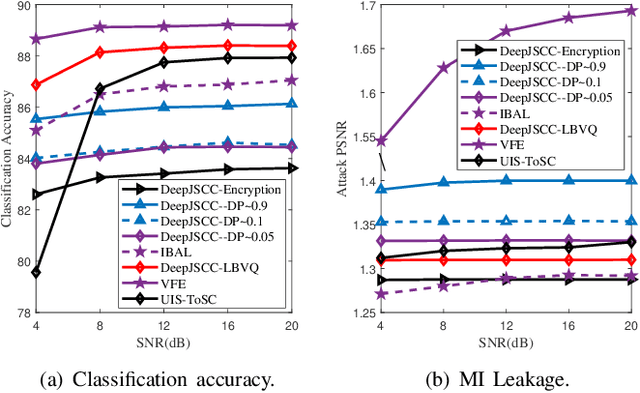
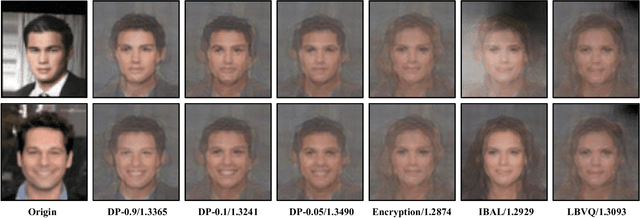
Abstract:Trustworthy task-oriented semantic communication (ToSC) emerges as an innovative approach in the 6G landscape, characterized by the transmission of only vital information that is directly pertinent to a specific task. While ToSC offers an efficient mode of communication, it concurrently raises concerns regarding privacy, as sophisticated adversaries might possess the capability to reconstruct the original data from the transmitted features. This article provides an in-depth analysis of privacy-preserving strategies specifically designed for ToSC relying on deep neural network-based joint source and channel coding (DeepJSCC). The study encompasses a detailed comparative assessment of trustworthy feature perturbation methods such as differential privacy and encryption, alongside intrinsic security incorporation approaches like adversarial learning to train the JSCC and learning-based vector quantization (LBVQ). This comparative analysis underscores the integration of advanced explainable learning algorithms into communication systems, positing a new benchmark for privacy standards in the forthcoming 6G era.
Semantic Importance-Aware Communications with Semantic Correction Using Large Language Models
May 25, 2024



Abstract:Semantic communications, a promising approach for agent-human and agent-agent interactions, typically operate at a feature level, lacking true semantic understanding. This paper explores understanding-level semantic communications (ULSC), transforming visual data into human-intelligible semantic content. We employ an image caption neural network (ICNN) to derive semantic representations from visual data, expressed as natural language descriptions. These are further refined using a pre-trained large language model (LLM) for importance quantification and semantic error correction. The subsequent semantic importance-aware communications (SIAC) aim to minimize semantic loss while respecting transmission delay constraints, exemplified through adaptive modulation and coding strategies. At the receiving end, LLM-based semantic error correction is utilized. If visual data recreation is desired, a pre-trained generative artificial intelligence (AI) model can regenerate it using the corrected descriptions. We assess semantic similarities between transmitted and recovered content, demonstrating ULSC's superior ability to convey semantic understanding compared to feature-level semantic communications (FLSC). ULSC's conversion of visual data to natural language facilitates various cognitive tasks, leveraging human knowledge bases. Additionally, this method enhances privacy, as neither original data nor features are directly transmitted.
Private Federated Learning with Dynamic Power Control via Non-Coherent Over-the-Air Computation
Aug 05, 2023
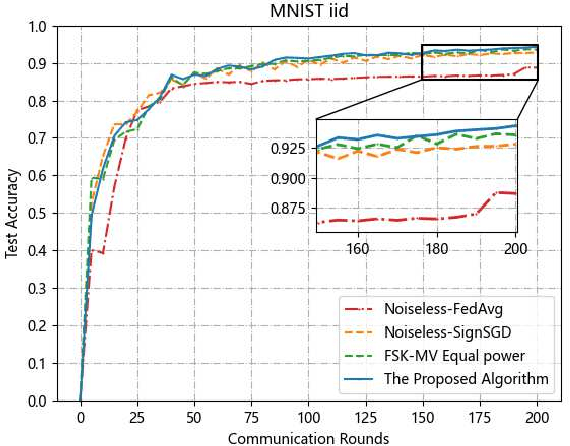
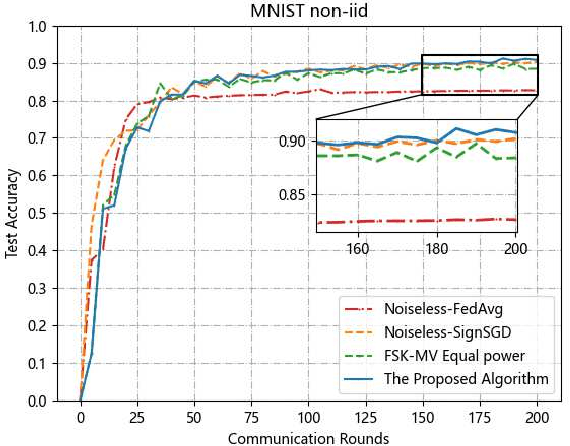
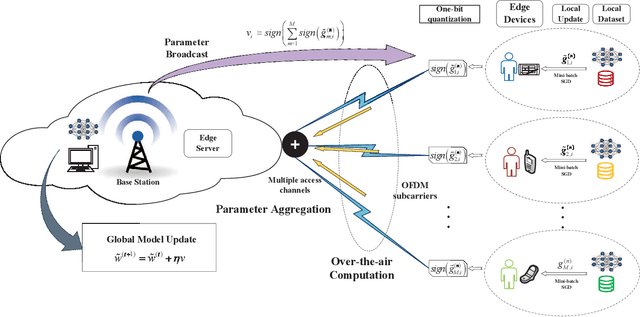
Abstract:To further preserve model weight privacy and improve model performance in Federated Learning (FL), FL via Over-the-Air Computation (AirComp) scheme based on dynamic power control is proposed. The edge devices (EDs) transmit the signs of local stochastic gradients by activating two adjacent orthogonal frequency division multi-plexing (OFDM) subcarriers, and majority votes (MVs) at the edge server (ES) are obtained by exploiting the energy accumulation on the subcarriers. Then, we propose a dynamic power control algorithm to further offset the biased aggregation of the MV aggregation values. We show that the whole scheme can mitigate the impact of the time synchronization error, channel fading and noise. The theoretical convergence proof of the scheme is re-derived.
 Add to Chrome
Add to Chrome Add to Firefox
Add to Firefox Add to Edge
Add to Edge